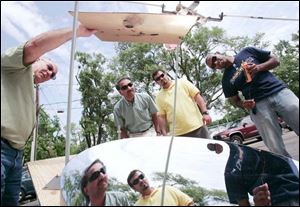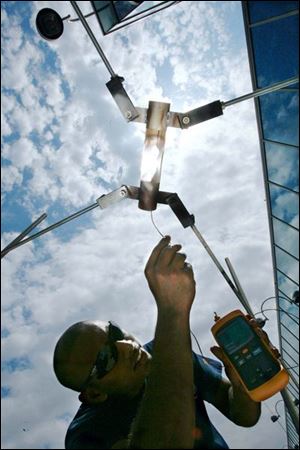
UT professor gets fuel from industry byproduct, rays from sun
10/17/2007
Setting cardboard afire to demonstrate their technology are, from left, Rob Dunmyer, machinist in the University of Toledo's chemical engineering department; Abdul-Majeed Azad, chemical engineer and associate professor; Sirhan Al-Batty, an undergraduate; and Sathees Kesavan, a PhD student.

Setting cardboard afire to demonstrate their technology are, from left, Rob Dunmyer, machinist in the University of Toledo's chemical engineering department; Abdul-Majeed Azad, chemical engineer and associate professor; Sirhan Al-Batty, an undergraduate; and Sathees Kesavan, a PhD student.
Even indoors, the polished aluminum lining of the 42-inch bowl is squint-inducing.
Outdoors, it's an inferno machine.
Cardboard held in the path of this solar collector catches fire in seconds. A temperature monitor that maxes out at 1,400 degrees Fahrenheit is quickly abandoned for one that can track the heat to the 2,500 degrees it soon reaches.
In minutes, the solar collector team members are all wearing wrap-around welding glasses, like engineering Men in Black.
But there's more to these solar pyrotechnics than blinds the eye.

Abdul-Majeed Azad, a chemical engineer and associate professor at the University of Toledo, is using sunlight to make hydrogen fuel from a steel industry byproduct.
Every year, steel manufacturers create many tons of iron oxide. Mr. Azad, 49, has found a way to use the material to unleash hydrogen from water via the same chemical process that produces rust, all under the power of the sun.
Steam passing over hot iron interacts with the iron surface. The iron grabs the oxygen in the steam, releasing the hydrogen. The problem is, the amount of hydrogen produced that way wouldn't pay for the process of making it.
But what if you could increase the surface area of the iron?
For Mr. Azad, the solution was to think small: like a billionth of a meter small - nanoscale. If the iron oxide could be converted into nanoscale particles, the surface area available for a chemical reaction would increase many thousands of times.
It's the difference between the surface area of a sugar cube and the surface area of thousands of sugar grains.
But in Mr. Azad's world view, sugar grains are enormous boulders.
A human hair is 80,000 nanometers wide, according to the National Nanotechnology Initiative.

Sathees Kesavan tests heat with a thermometer probe.
Mr. Azad and his team managed to scale the iron particles down to 5 to 20 nanometers.
At that scale, about 3.5 ounces of iron - think your average chocolate chip cookie - has the surface area of a football field.
Even without the solar-hydrogen production, nanoscale iron has other uses, Mr. Azad said.
Arsenic sticks to iron nanoparticles, which means the particles can filter arsenic from water.
His nanoparticles are being tested at a water purification project in Lahore, Pakistan, where natural arsenic levels in drinking water are high.
The industry publication, Nanotech Briefs, named Mr. Azad and his arsenic-hungry particles a Nano50 Award recipient - 50 promising technologies in the nanotech industry. The research will be featured in the publication's November issue.
"The judges deemed it to have high value," said Joe Pramberger, president of ABP International, the magazine's publisher. "These awards are based on their potential to have high impact on the commercial and business communities."
In fact, other nanoscale materials are used for purification, but the award is "not a question of being first," Mr. Pramberger said, but a question of being nearly ready for prime time.
Solar-powered hydrogen generation is not as far along the road to commercialization. In fact, it's too early to say if it can even make the trip.
The biggest question is cost.
"I'm holding my excitement until I get a better understanding of the cost model for recycling the iron oxide," said Rich Schwerdtfeger, the senior scientist who specializes in solar energy at the Edison Materials Technology Center.
The center, a nonprofit technology support group, provided some research funding to Mr. Azad's project.
To produce hydrogen, water is piped to a clear quartz cylinder above the solar collector. The heat of the collector turns the water to steam, which rushes across the iron nanoparticles in the same airtight cylinder. The iron captures the oxygen from the water. The remaining hydrogen is streamed toward a 12-volt fuel cell - powerful enough to light a driveway lamp.
Sathees Kesavan, 26, the doctoral student who has worked on the project from its inception three years ago, said the iron oxidized in the hydrogen-producing process then can be reprocessed into nanoscale material and used over and over again.
"In some ways, it's elegantly simple," said Joe Hager, senior scientist at the Edison center. "In other ways, it's rather sophisticated."
"I think it might be difficult to make this economically viable," he added. "But it's hard to know at the beginning of a process."
In a further effort to drive down the costs and improve the prospects for commercialization, undergraduate intern Sirhan Al-Batty, 27, has been working to reduce the steps needed to produce the nanoscale iron.
Despite the economic questions, Mr. Schwerdtfeger finds UT's pilot project promising.
"If I had a list of university projects generating hydrogen, I would prioritize this one very high in terms of potential to be commercialized," he said.
But Mr. Azad's effort is far from the only one in the field.
In fact, UT physicist Xunming Deng also has a solar-powered process to generate hydrogen from water.
Contact Jenni Laidman at: jenni@theblade.com or 419-724-6507.